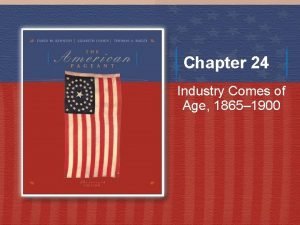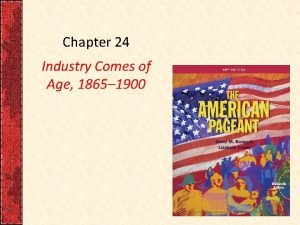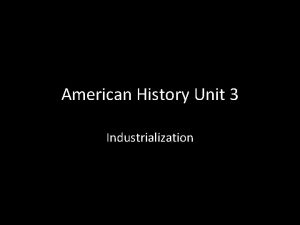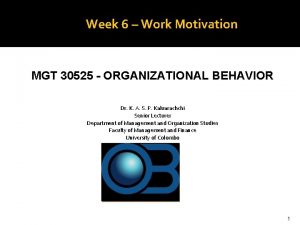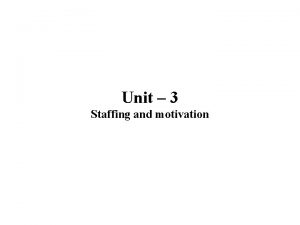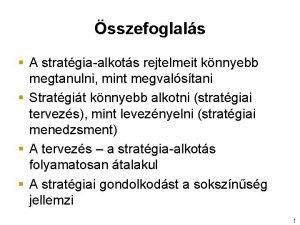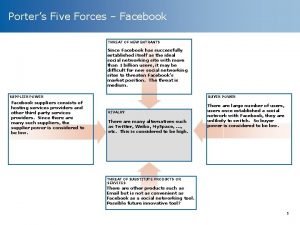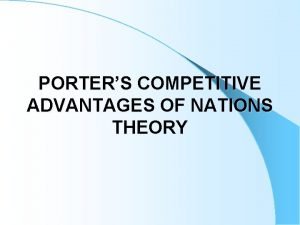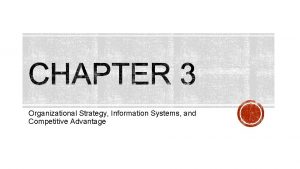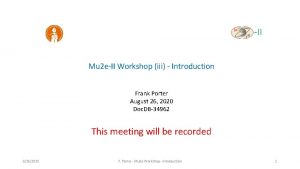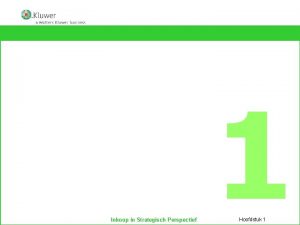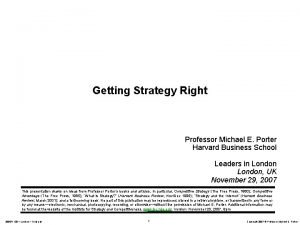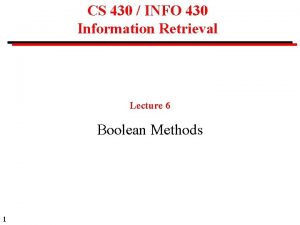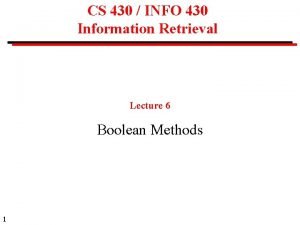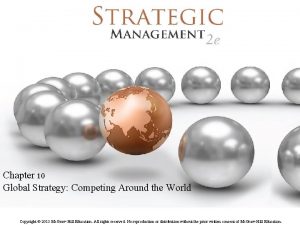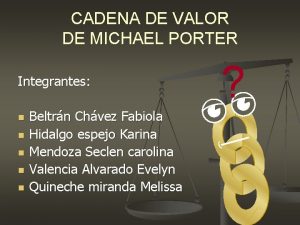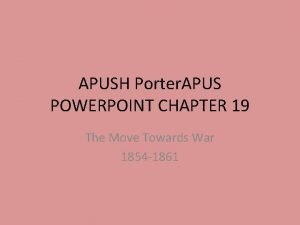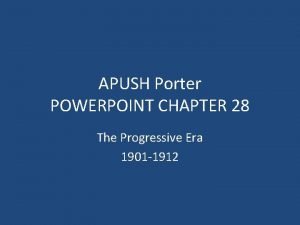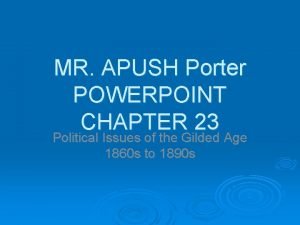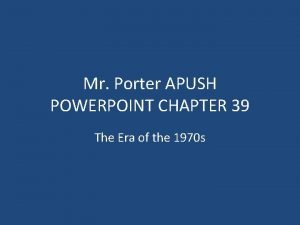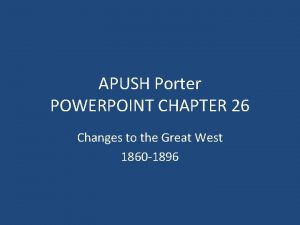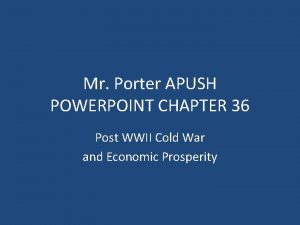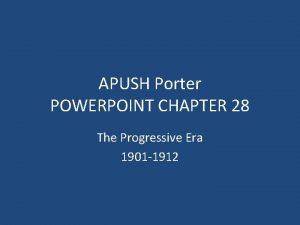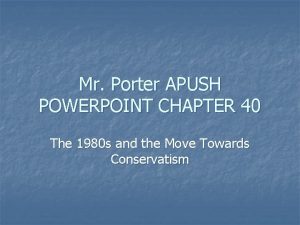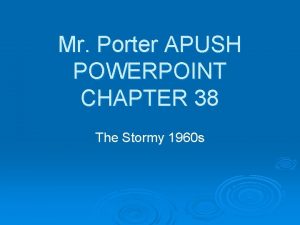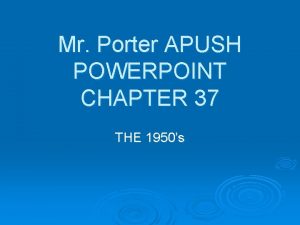APUSH Porter POWERPOINT CHAPTER 24 Industry Comes of

















































- Slides: 49

APUSH Porter POWERPOINT CHAPTER 24 Industry Comes of Age 1865 -1900

Keys to the Chapter • • Growth of Railroads The Grange Movement Massive Immigration Rise of the “Robber Barons” { Industry Giants} • Shift to wage dependence from land dependence • Unions struggle for a foot hold

Railroads • 1865 – 1900 Government gave railroad subsides in land to help offset the risk (both state and federal governments did this) & land used as collateral for loans to build the railroads • Railroads used land as collateral for loans or sold it for money (average of $3 per acre)

• Justifying the giveaway of the land – Government got lower rates for postal services and military traffic – Cheap way to subsidize railroads, without passing new taxes or cash – R. R. increased value of government’s land – Railroads brought civilization to the West

• Two Major R. R. build transcontinental R. R. – Union Pacific starts in Nebraska with mostly Irish immigrants doing the work & goes West – Central Pacific starts in California and used mostly Chinese immigrants to do the work – They meet on 5/10/1869 at Promontory Point, Utah and the Golden Spike is put in the ground

Promontory Point, Utah May 10, 1869

• Organizing the railroad lines – Vanderbilt organized and expanded the New York Central line which is very profitable – Distance between the 2 tracks (gauge) standardized – Westinghouse air brake and Pullman Palace cars – Safety devices: • Telegraph for communication • Double-tracking (so railroads weren’t going opposite directions on same tracks) • Block signal ( prevent 2 trains going opposite directions from being on same track at same time) • Standardized time zones (1883 - 4 zones)

• Railroads bring the following: – Unity between the states – Industrialization and huge demand for steel – Boom in mining and agriculture – Increased population in West – Increased immigration from Europe and Asia – -----------------------------– But also bring destruction to land Indian way of life and the end of the “open range” – Also bring stock speculation, “rip off artists”, and land speculators

• Stock watering: Jay Gould – Selling stock far beyond what it was worth – R. R. forced to charge high rates and fight competitive battles with rival railroads to make railroad worth high stock price – Fierce Competition would require lower prices thus preventing actual profit from occurring – Bribery of politicians and journalists

• Railroads began working together rather than competing to reward investors at the expense of railroad users – Pools • Agreement to divide the business of a certain area and share the profits – Rebates or kickbacks • Given to large shippers to gain steady traffic • Lower profit made up by charging higher prices for short hauls or on small shippers

History Repeats Itself – Middle Ages and Today

• Farmers in Midwest hurt by railroad abuses – Depression in 1870 s finally moved farmers to protest railroad abuses – Farmers (led by organized farmers’ groups like the Grange) worked at state level to regulate railroads – BUT most Americans believed in Lazzie-Faire which requires government to stay out of business issues

• Farmers use state legislatures to pass laws regulating railroad abuses. • Railroads turn to FED court for help • 1886 – Wabash v. Illinois – Supreme Court ruled that states could not regulate interstate (between states) commerce – Only federal government could regulate interstate commerce so pressure put on Feds

• 1887 – Interstate Commerce Act (ICC) passed – Prohibited rebates and pools – Stopped unfair discrimination against shippers – Require same for short hauls & long hauls – (ICC) set up to enforce the law This helped RR’s because now avoid costly wars and instead begin to control regulatory process First large-scale attempt by federal government to regulate business in interests of society

Post Civil War Industrialization • Liquid Capital ($) becomes available (Europe) • Natural Resources are plentiful (coal, oil, iron) • Immigration provides supply of cheap labor • Inventions enable mass production • Urbanization speeded by refrigerator car, electricity and electric railway


• The telephone – Invented by Alexander Graham Bell in 1876 – Brought nationwide communication to U. S. – Brought women to work on switchboard Electricity developed by Thomas Edison – Invented many things like phonograph, moving picture, and (most famously) the light bulb

• Vertical integration – Combining into 1 organization all phases of manufacturing and production thus being able to control quality, quantity and costs – Best exemplified by Andrew Carnegie’s steel corporation, in which every part of making steel was integrated into 1 company

Vertical Integration as developed by Andrew Carnegie in steel manufacturing

• Horizontal integration – Uniting with competitors to monopolize – Rockefeller trusts are an example of this • Stockholders in smaller oil companies gave control of their stock to the board of Standard Oil Company • The board then controlled all “competing” companies in the industry • Smaller companies left out of the trust eliminated with ruthless competition – Businesses in other industries begin to copy this approach

Horizontal Integration made famous by Rockefeller and oil trusts

• Interlocking directorate – Devised by J. P. Morgan during depression in 1890 s to control financial institutions – Hurting companies were bought out by Morgan’s banks who then put officers from his banks on boards of various “competing” companies to eliminate “wasteful” competition – He will use his vast sums of $ to buyout Andrew Carnegie and create US Steel

Steel Production 1880– 1914 Reduces importance of Europe

– Bessemer process • Cold air on very hot iron ignited carbon in the ore and burned out the impurities • Made cheap production of high-quality steel – America had important natural resources close together • Coal (for fuel), iron ore, other important ingredients

Andrew Carnegie was king of steel: Scottish immigrant who rose from poverty to wealth and then gave almost all away

• 1900 Morgan buys out Carnegie and Carnegie believes he will die “disgraced” if he dies with all his wealth – Spends rest of his life giving away $350 million ($50 m left) • Money given to libraries and universities to help people improve themselves • The leader of the “Gospel of Wealth” theory

• Emergence of the oil industry – 1859 – first oil well in Pennsylvania drilled – Kerosene became first important derivative of oil ; better than whale oil – Late 1800 s – invention of light bulb by Edison made burning kerosene obsolete • Mid 1890 s – automobile invented, burning gasoline for power – Internal combustion engine gave oil industry a huge, profitable boost

John D. Rockefeller Organizes Standard Oil Company to dominate the oil industry

• Positives of Rockefeller’s Standard Oil – Produced superior product at lower price – Achieved economies of scale because his business was so big • Producing a lot of oil by 1 company much more efficient than using many smaller companies (think Microsoft) Negatives of Rockefeller’s approach was that business became more powerful than the government

What a Puny Little Government

• Domination of trusts begins: – sugar, tobacco, leather, harvester, meat – New rich eclipsing old rich who had inherited their money – Old rich were the leaders of the groups who attacked the new industrialists out of fear of being replaced

The Gospel of Wealth argues Darwinism. . . Survival of the fittest • Blame the poor justification – New rich had become rich through hard work – Poor are lazy and can only blame themselves – Law also used (Constitutional arguments) to prevent break-up of Corporations because would be unlawful “taking of property” without compensation {14 th protects corps)

Who is “strong” and who is “weak”?

• Public starts to oppose trusts and newspapers rally against trusts – Federal regulation then passed to regulate and control trusts – Sherman Anti-Trust Act of 1890

• Sherman Anti-Trust Act of 1890 – Forbade combinations in restraint of trade – No distinction made between “good” and “bad” trusts – At first was ineffective • Little power given to government • Most cases decided in favor of corporations • Used to control unions (labor combinations) • Eventually strengthened in 1914 to stop trusts

• South lacks growth of industry: – Sharecropping and tenant system controlled by absentee landlords • 1880 s – rise of pre-rolled cigarettes and in 1890 American Tobacco Company formed – 1880 s – North put more cotton mills in South • Lower taxes and cheap labor in South • Mills located in poorest regions because labor was cheapest (same today for car companies)

• Women Join Workforce – Worked as secretaries, telephone operators, and in factories with men – Middle class women put off marriage and had smaller families – Poor women worked out of economic necessity – Women’s wages stayed lower than men’s

• Foreign trade is expanded – US manufacturers trade with foreign countries when US could not absorb enough of their products – US military used to protect US business abroad, and to build a US empire – Wage earners did not share profits proportionately with business owners – 1900 – 1/10 of the people owned 9/10 of the wealth in the US


• Workers begin to organize together to fight for basic rights : – Found many obstacles to a successful fight against employers • Oversupply of labor drives down wages • New Machines increase productivity which means less workers needed • Employment is no longer personal (small shops) but instead is large and impersonal

• Corporations import strike-breakers (“scabs”) and pay thugs to beat up strike organizers • Corporations get conservative judges to issue injunctions against strikes (forcing them to stop) – If workers did not end strike, state or federal troops could be called out to forcibly put down the strike

• Corporations use “lockouts” (lock factory doors against workers) to starve them into submission • Corporations force workers to sign “ironclad oaths” or “yellow-dog contracts” which were agreements not to join a union • Corporations put agitators’ names on “black list”, & give lists to other employers so that these people could not find work

• Some corporations used “company town” where company owned housing, stores and provided credit to workers, putting them in continuous debt • Middle class had little sympathy for workers – Low wages were still highest in the world – Believed poor could work hard to improve their condition, as others had done before – Strike seen as socialistic, un-American import from Europe – God would take care of poor and weak with charities

• National Labor Union – Organized in 1866; lasted 6 years – Represented 600, 000 workers at peak (skilled, unskilled, farmers) – Did not accept Chinese, women, or blacks – Destroyed by depression in early 1870 s • Knights of Labor – – Organized in 1869 Began as a secret society to prevent retaliation Represented 750, 000 workers at peak Called for organizing all workers • Skilled, unskilled, women, blacks, – Called for producers’ cooperatives, codes for safety and health of workers, 8 -hour day

Haymarket Square: – May 4, 1886 – police attacked a peaceful meeting protesting police brutalities • Dynamite bomb thrown, killing several dozen people (including some police) • 8 people (the Chicago 8) rounded up – No proof they had anything to do with the bombing – Judge ruled that since they had made speeches that incited violence, they were responsible for the bomb – 5 sentenced to death, 3 given long prison terms – Later those still alive are pardoned by Governor

• Haymarket Square destroyed the Knights – Became associated with anarchists and violence • Knights’ other fatal weakness was bringing together unskilled and skilled workers – Unskilled workers easily replaced, nullifying effectiveness of strikes – Skilled workers got tired of being held back by unskilled workers so left Knights

• American Federation of Labor (AFL) formed 1886 • Led by Samuel Gompers, skilled cigar maker – Association of self-governing national unions – Each union kept its independence, while AFL made overall strategy • Gained 500, 000 skilled members • In reality, only represented skilled workers • Used walkouts and boycotts to combat business abuses

• Gompers: – Hated socialism, rejected politics in favor of concrete economic goals for workers • Better wages, fewer hours, better conditions • Unlike Knights of Labor, concerned with more practical (and realistic) goals – “trade agreement” authorizing the “closed shop” • Gompers got some businesses to only hire union members – AFL was non-political except for supporting friends of the union and voting against enemies

• Public attitudes toward workers began to change in the late 1880 s and 1890 s: – Public acknowledged workers right to join unions and strike – Businesses work with unions to avoid strikes – Most businesses were still opposed to unions • 30 years of strikes and violence would be needed before labor finally gained recognition and power to stand up to business in the 1930 s
 Chapter 24 industry comes of age
Chapter 24 industry comes of age Chapter 24 industry comes of age
Chapter 24 industry comes of age First comes love then comes marriage
First comes love then comes marriage Robber barons/captains of industry apush definition
Robber barons/captains of industry apush definition Robber barons/captains of industry apush definition
Robber barons/captains of industry apush definition Something wicked this way comes chapter summary
Something wicked this way comes chapter summary Charlie and the chocolate factory prince pondicherry
Charlie and the chocolate factory prince pondicherry Chapter 2 chemistry comes alive answer key
Chapter 2 chemistry comes alive answer key Something wicked this way comes chapter summary
Something wicked this way comes chapter summary Chapter 2 chemistry comes alive
Chapter 2 chemistry comes alive Phsc pert
Phsc pert Equity theory
Equity theory Porter versenystratégia
Porter versenystratégia Checklist verandermanagement
Checklist verandermanagement Porter and lawler theory
Porter and lawler theory Cadena de valor
Cadena de valor Vantagem competitiva porter
Vantagem competitiva porter Fortele lui porter
Fortele lui porter Vállalati értéklánc
Vállalati értéklánc Porters generic competitive strategies
Porters generic competitive strategies Rejtelmeit
Rejtelmeit Stanley porter deloitte
Stanley porter deloitte Distribution red bull
Distribution red bull Firm infrastructure in value chain
Firm infrastructure in value chain Five forces model facebook
Five forces model facebook Porters 3 generic strategies
Porters 3 generic strategies Porter's theory
Porter's theory Slidetodoc
Slidetodoc What are porter's four competitive strategies?
What are porter's four competitive strategies? Porter’s generic strategies
Porter’s generic strategies Nestle segmentation
Nestle segmentation Aims and objectives of motivation
Aims and objectives of motivation Porter and lawler theory
Porter and lawler theory Porter értéklánc
Porter értéklánc Attitudes de porter
Attitudes de porter Porter analisi
Porter analisi Frank porter caltech
Frank porter caltech Waarde keten porter
Waarde keten porter Michael e porter harvard
Michael e porter harvard értékteremtő folyamatok
értékteremtő folyamatok Estrategias genericas de porter
Estrategias genericas de porter Eliot porter biography
Eliot porter biography Michael porter biografia
Michael porter biografia Como hacer un diamante de porter
Como hacer un diamante de porter Costa coffee porter's five forces
Costa coffee porter's five forces Porter stemmer algorithm steps
Porter stemmer algorithm steps Porter stemmer algorithm steps
Porter stemmer algorithm steps Liability of foreignness
Liability of foreignness Cadena de valor de porter
Cadena de valor de porter Policeman tip hand deformity
Policeman tip hand deformity
